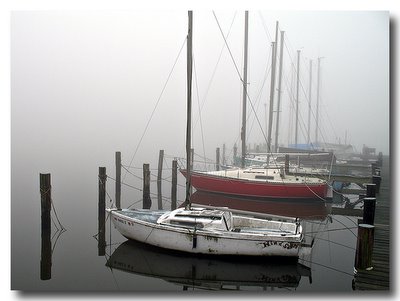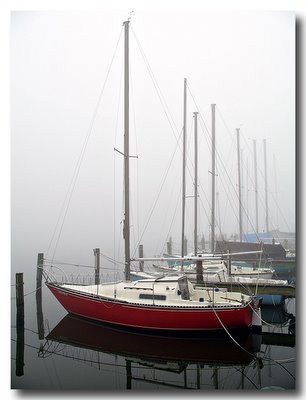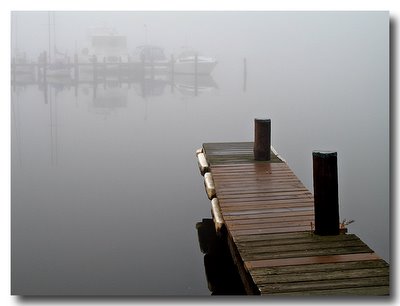Friday, January 13, 2006
Canon A620 - My First 150 Shots
Spending the last two weeks with a digicam after over two years of using a DSLR has been both jarring and rewarding.
 I'd forgotten how much I've been taking for granted with my DSLR. ISO 400 is probably the most significant. For two years, I've been running around taking photos with the resolution of Kodachrome 25 and the effective film speed of Tri-X. What a deal! The relatively large (22.7 mm x 15.1 mm) sensor of the Digital Rebel has, relatively speaking, large pixel sites. Large pixels translates to less noise. On the other hand, the Canon A620 has about 17% more pixels than the Digital Rebel crammed into a little 7.2 mm x 5.3 mm chip - that's one-ninth the area of the DSLR sensor. So while you can crank the A620 up to ISO 400, you don't want to.
I'd forgotten how much I've been taking for granted with my DSLR. ISO 400 is probably the most significant. For two years, I've been running around taking photos with the resolution of Kodachrome 25 and the effective film speed of Tri-X. What a deal! The relatively large (22.7 mm x 15.1 mm) sensor of the Digital Rebel has, relatively speaking, large pixel sites. Large pixels translates to less noise. On the other hand, the Canon A620 has about 17% more pixels than the Digital Rebel crammed into a little 7.2 mm x 5.3 mm chip - that's one-ninth the area of the DSLR sensor. So while you can crank the A620 up to ISO 400, you don't want to.
I've been sticking to ISO 50 or 100, and that means that at times, I get the little "shaky camera" icon on the LCD screen, indicating that the shutter speed is kinda low.
 The other thing that's come to me is that for eighty percent or so of my picture-taking, looking through an SLR viewfinder beats looking at an LCD screen. Not that the A620's screen isn't excellent - it really is. As these things go, it's big, bright, and has that twisty-flexy feature for those shots where you want to use it as a waist-level finder or shoot over the heads of the crowd. But in bright sunlight, it still gets washed out and hard to see. Also, holding up a camera and looking at its back is just not the steadiest way to hold a camera.
The other thing that's come to me is that for eighty percent or so of my picture-taking, looking through an SLR viewfinder beats looking at an LCD screen. Not that the A620's screen isn't excellent - it really is. As these things go, it's big, bright, and has that twisty-flexy feature for those shots where you want to use it as a waist-level finder or shoot over the heads of the crowd. But in bright sunlight, it still gets washed out and hard to see. Also, holding up a camera and looking at its back is just not the steadiest way to hold a camera.
And so far, that's about it for the downside. Other than these two things, I really like the A620. Also, keep in mind that what I've said so far applies to small-sensor digicams in general and doesn't represent a shortcoming of the A620 itself.
Canon's designers did a great job of making the A620 easy to operate. Pretty much anything you would want to do on a frequent basis is easy to get at with a press of your right thumb of one of the logically laid-out controls on the camera back.
There's even a "Custom" mode that allows you to instantly get to your favorite settings by turning the mode dial to "C." For example, the "rock-and-roll" shooting mode (hold down the shutter button and it keeps taking pictures) normally resets to single-shot mode when you turn the camera off and on. But you can save the multi-shot mode as one of settings for your Custom mode (which is what I do.) I'm sure this was mentioned in one of the several reviews I read, but I don't remember seeing it - so I was pleasantly surprised by this feature.
The camera provides for lots of flexibility for those of us who think of ourselves as real photographers. In aperture-priority mode, which I use, you can easily set exposure compensation, flash exposure compensation, change auto-focus zones, and even manually focus the lens.
One of my favorite features is the option to display a grid on the LCD that divides the frame into thirds, horizontally and vertically. Sort of a rule-of-thirds detector, and it helps keep straight lines straight, when that's what you want. I wish the Canon DSLRs had this (I think Nikon D70 does?)
 Of course, the main reason I bought the camera is that it's small enough to take pretty much everywhere. So far, I've done just that every day since I got the camera. I either put it in a jacket pocket or shove it into an old 1983 Canon Sure-Shot case and throw it into the bag I carry with me to work.
Of course, the main reason I bought the camera is that it's small enough to take pretty much everywhere. So far, I've done just that every day since I got the camera. I either put it in a jacket pocket or shove it into an old 1983 Canon Sure-Shot case and throw it into the bag I carry with me to work.
And it pays - today I stopped by the Severn River on the way to work and, in the morning fog, took the pictures you see here today.
In conclusion, so far, so good. I'll be using the A620 a lot over the next few weeks and will have more to say, especially about its ability to deliver big prints.
Stay tuned.
 I'd forgotten how much I've been taking for granted with my DSLR. ISO 400 is probably the most significant. For two years, I've been running around taking photos with the resolution of Kodachrome 25 and the effective film speed of Tri-X. What a deal! The relatively large (22.7 mm x 15.1 mm) sensor of the Digital Rebel has, relatively speaking, large pixel sites. Large pixels translates to less noise. On the other hand, the Canon A620 has about 17% more pixels than the Digital Rebel crammed into a little 7.2 mm x 5.3 mm chip - that's one-ninth the area of the DSLR sensor. So while you can crank the A620 up to ISO 400, you don't want to.
I'd forgotten how much I've been taking for granted with my DSLR. ISO 400 is probably the most significant. For two years, I've been running around taking photos with the resolution of Kodachrome 25 and the effective film speed of Tri-X. What a deal! The relatively large (22.7 mm x 15.1 mm) sensor of the Digital Rebel has, relatively speaking, large pixel sites. Large pixels translates to less noise. On the other hand, the Canon A620 has about 17% more pixels than the Digital Rebel crammed into a little 7.2 mm x 5.3 mm chip - that's one-ninth the area of the DSLR sensor. So while you can crank the A620 up to ISO 400, you don't want to.I've been sticking to ISO 50 or 100, and that means that at times, I get the little "shaky camera" icon on the LCD screen, indicating that the shutter speed is kinda low.
 The other thing that's come to me is that for eighty percent or so of my picture-taking, looking through an SLR viewfinder beats looking at an LCD screen. Not that the A620's screen isn't excellent - it really is. As these things go, it's big, bright, and has that twisty-flexy feature for those shots where you want to use it as a waist-level finder or shoot over the heads of the crowd. But in bright sunlight, it still gets washed out and hard to see. Also, holding up a camera and looking at its back is just not the steadiest way to hold a camera.
The other thing that's come to me is that for eighty percent or so of my picture-taking, looking through an SLR viewfinder beats looking at an LCD screen. Not that the A620's screen isn't excellent - it really is. As these things go, it's big, bright, and has that twisty-flexy feature for those shots where you want to use it as a waist-level finder or shoot over the heads of the crowd. But in bright sunlight, it still gets washed out and hard to see. Also, holding up a camera and looking at its back is just not the steadiest way to hold a camera.And so far, that's about it for the downside. Other than these two things, I really like the A620. Also, keep in mind that what I've said so far applies to small-sensor digicams in general and doesn't represent a shortcoming of the A620 itself.
Canon's designers did a great job of making the A620 easy to operate. Pretty much anything you would want to do on a frequent basis is easy to get at with a press of your right thumb of one of the logically laid-out controls on the camera back.
There's even a "Custom" mode that allows you to instantly get to your favorite settings by turning the mode dial to "C." For example, the "rock-and-roll" shooting mode (hold down the shutter button and it keeps taking pictures) normally resets to single-shot mode when you turn the camera off and on. But you can save the multi-shot mode as one of settings for your Custom mode (which is what I do.) I'm sure this was mentioned in one of the several reviews I read, but I don't remember seeing it - so I was pleasantly surprised by this feature.
The camera provides for lots of flexibility for those of us who think of ourselves as real photographers. In aperture-priority mode, which I use, you can easily set exposure compensation, flash exposure compensation, change auto-focus zones, and even manually focus the lens.
One of my favorite features is the option to display a grid on the LCD that divides the frame into thirds, horizontally and vertically. Sort of a rule-of-thirds detector, and it helps keep straight lines straight, when that's what you want. I wish the Canon DSLRs had this (I think Nikon D70 does?)
 Of course, the main reason I bought the camera is that it's small enough to take pretty much everywhere. So far, I've done just that every day since I got the camera. I either put it in a jacket pocket or shove it into an old 1983 Canon Sure-Shot case and throw it into the bag I carry with me to work.
Of course, the main reason I bought the camera is that it's small enough to take pretty much everywhere. So far, I've done just that every day since I got the camera. I either put it in a jacket pocket or shove it into an old 1983 Canon Sure-Shot case and throw it into the bag I carry with me to work.And it pays - today I stopped by the Severn River on the way to work and, in the morning fog, took the pictures you see here today.
In conclusion, so far, so good. I'll be using the A620 a lot over the next few weeks and will have more to say, especially about its ability to deliver big prints.
Stay tuned.
Comments:
<< Home
I'm a glutton for sailboat photos like these, Steve, especially in the mists. I can tell you're loving your camera :)
Post a Comment
<< Home




